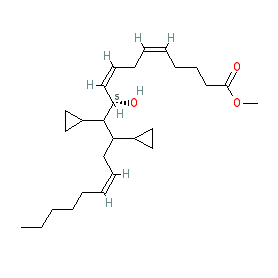GtoPdb is requesting financial support from commercial users. Please see our sustainability page for more information.
|
Compound class:
Synthetic organic
Comment: PBT-3 is a stable hepoxilin analogue, that antagonises hepoxilin effects in vitro and in vivo [3-4]. Hepoxilin A3 is an unstable lipid mediator (a proinflammatory eicosanoid derived from arachadonic acid) that acts as a potent neutrophil chemoattractant in the acute phase of the inflammatory response, and has been implicated in the process of NETosis by human neutrophils [1].
Ligand Activity Visualisation ChartsThese are box plot that provide a unique visualisation, summarising all the activity data for a ligand taken from ChEMBL and GtoPdb across multiple targets and species. Click on a plot to see the median, interquartile range, low and high data points. A value of zero indicates that no data are available. A separate chart is created for each target, and where possible the algorithm tries to merge ChEMBL and GtoPdb targets by matching them on name and UniProt accession, for each available species. However, please note that inconsistency in naming of targets may lead to data for the same target being reported across multiple charts. ✖ |
|
|||||||||||||||||||||||||||||||||||
| References |
|
1. Douda DN, Grasemann H, Pace-Asciak C, Palaniyar N. (2015)
A lipid mediator hepoxilin A3 is a natural inducer of neutrophil extracellular traps in human neutrophils. Mediators Inflamm, 2015: 520871. [PMID:25784781] |
|
2. Pace-Asciak CR. (2015)
Pathophysiology of the hepoxilins. Biochim Biophys Acta, 1851 (4): 383-96. [PMID:25240838] |
|
3. Qiao N, Reynaud D, Demin P, Halushka PV, Pace-Asciak CR. (2003)
The thromboxane receptor antagonist PBT-3, a hepoxilin stable analog, selectively antagonizes the TPalpha isoform in transfected COS-7 cells. J Pharmacol Exp Ther, 307 (3): 1142-7. [PMID:14560042] |
|
4. Reynaud D, Hinek A, Pace-Asciak CR. (2002)
The hepoxilin analog PBT-3 inhibits heparin-activated platelet aggregation evoked by ADP. FEBS Lett, 515 (1-3): 58-60. [PMID:11943194] |
|
5. Siangjong L, Goldman DH, Kriska T, Gauthier KM, Smyth EM, Puli N, Kumar G, Falck JR, Campbell WB. (2017)
Vascular hepoxilin and trioxilins mediate vasorelaxation through TP receptor inhibition in mouse arteries. Acta Physiol (Oxf), 219 (1): 188-201. [PMID:26666460] |







